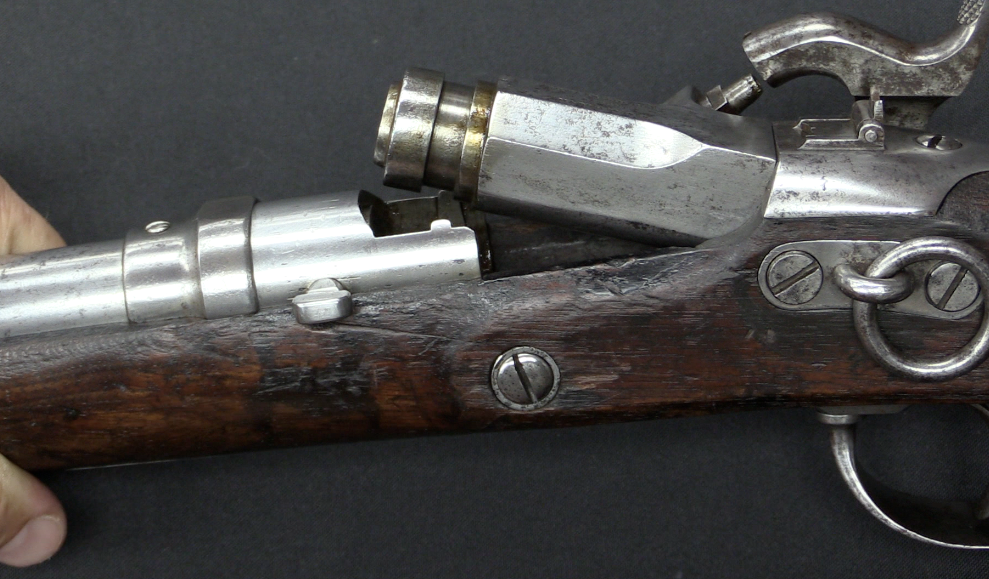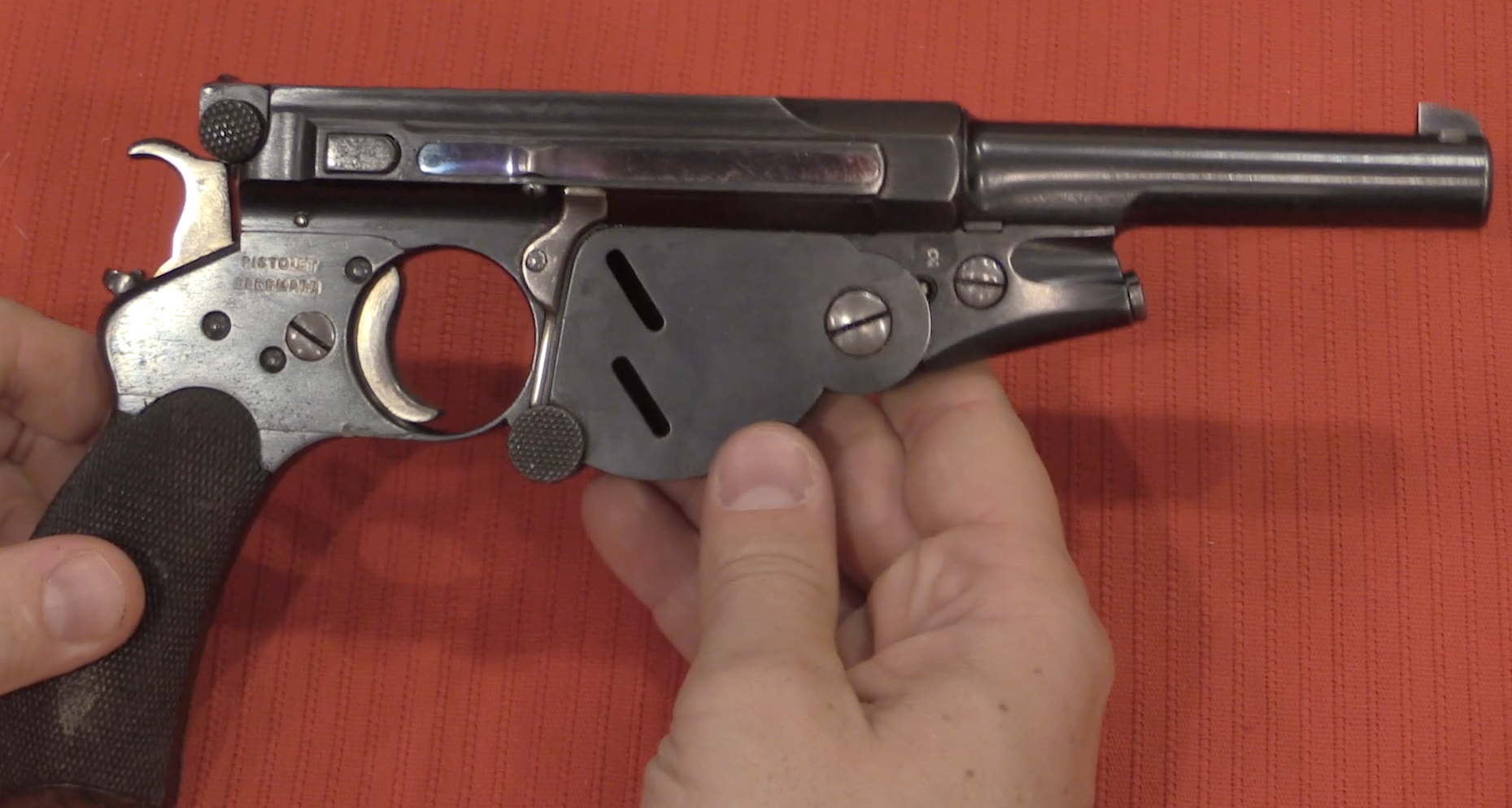We’re taking a look at another artillery piece today, a 50mm mountain gun made for Siam (now Thailand) by the German Krupp company. It is a relatively simple (and thus relatively inexpensive at the time) design, with no recoil mechanism or adjustable traverse:
Related Articles

Paper cartridge
RIA: Lindner Carbine

Bergmann
Bergmann Transitional No 4/5 Pistols

Bolt Action Rifles

You’re right, that’s a very cool little gun! I like the way unnecessary parts and features have been omitted to keep weight and cost down. That seems to be a forgotten idea in today’s weapon systems. A recoil system and a traverse crank are nice to have, but you would need another elephant.
I shared this on the Facebook page as well. The gun reminds me of a video I saw 20-20 years ago about a British gun moving competition based on, as I recall, howitzers used in India. The competition was to simulate moving the gun through the mountains. Someone uploaded a video from a competition from 1997.
http://youtu.be/VslIuK-bAHg
It’s called the Gun Carriage Race, and it commemorates the Royal Navy landing parties use in the the Boer War.
This race from 1999 has the best explanation that I’ve seen of it. The commentator gives the weights of the various components of the gun, which might interest some people here. It’s a larger gun than the one used in Ian’s video, but the teams still sling them around like they were feathers.
https://www.youtube.com/watch?v=32s4qCCFnmk
Despite the impression you might get from the commentator the race still goes on today. The teamwork and strength required are very impressive.
Thanks!
the cannon i always wanted , an artical on this gun many years ago got me going on cannons
I liked the admonition at the end…”Tune into Forgottenweapons dot BRRRRRRAAAAPPP!!! I can safely conclude the missing word was com???
CB in FL (aka Broz):-)))
cool gun , but why egractly isn’t this a destructive device ?
i also found a vidio that talks more about the gun
https://www.youtube.com/watch?v=0etdjCxR9PE
https://www.youtube.com/watch?v=MjUjYR-hbY0
Thank you, very nice set of video ‘juver’!
Now I can see that with spade of trail located into groove in soil changes recoil effect dramatically.
One item of concern of this otherwise perfectly synchronized crew is that loader’s hand may be at risk as firer may close breech too early. Should not loading and closing breech be done by one person and with same hand?
Mountain guns like this were very common with colonial forces in the 1800s. Considering their intended targets (irritable locals), they didn’t need to be too sophisticated, and in fact the simpler they were, the less there was to go wrong.
The most common way to move them was on muleback, as Ian said. Most came apart into four sections; One tube, one trail, two wheels. Three mules carried the gun (one got the two wheels) while there were generally two or three more per tube to carry the ammunition, kit, etc.
The British 2.5in ML version was unusual in that its tube came apart into two sections, threaded together. And yes, this was the origin of Kipling’s poem “Screw Guns”;
http://www.poetryloverspage.com/poets/kipling/screw_guns.html
The mountain guns were superseded by the Stokes-type mortars in the 1920s and ’30s. Lighter and easier to transport, easier to set up in a hurry, and about as accurate, plus longer range and higher lethality.
A 2in mortar round had about as much HE filling as a 2.5in mountain gun shell, and could “reach out and touch someone” over intervening high ground or even shooting down into a valley from a mountainside. (Maximum over-elevation & no zone charges generally “got ‘er done”.) That sort of shooting with a non-recoil mountain gun was less of an exercise in practical gunnery and more of a conjuring trick. (Somebody generally had to prop the trail up somehow…..)
cheers
eon
Thanx for the link to Kipling!!!
Mountain guns with no recoil mechanism were pretty much being phased out before WW1 already, although the need to manufacture more guns, no matter if they were modern or not, brought back some obsolescent designs during the war. Most notably the Italians restarted the production of the 70mm M1902 (Cannone da 70/15 Mod. 1902 by Italian WW2 nomenclature) despite already having the newer 65mm M1908/1913 gun in service and production. The Alpine front against Austria required a lot of mountain guns and for direct fire applications the lack of recoil mechanism was not a very serious shortcoming. The gun remained in second line service (mostly by the frontier guard artillery units) until 1943 officially, although probably some also served with the RSI (Italian Social Republic) army in Northern Italy until 1945.
To say that the Stokes mortars replaced mountain guns is not entirely correct. The 65-105 mm mountain guns had a much longer range in indirect mode than any smooth bore mortars available at the time, and they were more useful for direct fire. Nearly all countries with significant mountainous areas kept mountain guns in service until the end of WW2 and in some cases beyond. The US 75mm pack howitzer M1 (M116) developed in the 1920s was a direct descendant of mountain guns, and in the 1950s OTO-Melara designed the 105mm Mod. 1956 pack howitzer. Both of them are still in use by some armies, although the latter is not in practice transportable by pack animals. It can still be broken up to parts which can be transported by light trucks over a difficult terrain more readily than any towed artillery piece.
What finally killed mountain guns and pack howitzers was the development of 120mm heavy mortars during and after WW2. They fire a much more effective HE shell than even 105mm howitzers, their range is nearly as good the best pack howitzers, and they weigh less than half as much as the 75mm pack howitzers.
An article back in the 1970s in Guns & Ammo showed a Siamese Krupp 2,95 Inch Mountain Gun, in working order, and the Repro shells made for it from cut-off 40mm Bofors casings. Worked well too ( DD AFTE ).
The Japanese also had a similar (NO Recoil) Mountain Gun, based on the Schneider (French) 65mm. And the Italians had a Alpine Artillery Piece, Cal 65mm, in WW I, but this was soon supplanted by the Demountable Skoda 75mm,both from capture during WW I, and as reparations after from Austria Hungary.. The Skoda design led to the design (Post WW II) of the 105mm Pack Howitzer ( Italian design, Nato adopted.)
Doc AV
Very good supplementary info Doc!
As far as I know, the only Japanese mountain gun with no recoil mechanism was the old 7cm Mountain Gun from 1883, which even had an old fashioned bronze barrel and was designed with Italian assistance. The later Type 31 (Meiji year 31, i.e. 1898) 75mm mountain gun designed by Colonel Arisaka had a primitive but surprisingly functional “semi-regid” recoil system with spring buffers.
The Italian 65mm Mod. 1908/1913 mountain gun remained in service throughout WW2 as an infantry and emergency AT gun, and actually saw considerably more service than the 75mm Skoda mountain gun. The 65mm gun was common in North Africa and was also mounted on trucks as a makeshift SP artillery. After the Italian armistice the Germans captured a lot of them with large ammo stocks from Italian Royal Army units in the German occupation areas and used them extensively in Italy.
This is another one…The Command Field Gun Run 2013 – you get to see more of the details of the team set-ups:
https://www.youtube.com/watch?v=7G-vQjBFU-4
CB in FL…I have a friend, retired from the US Navy in ’09 who was chosen to participate in one of these competitions…his team won…
Hi Ian,
for some reason I stopped getting updates by email. Have just spent half a day catching up on reading and videos. Really enjoyed this mountain gun one. I remember reading in some gun magazine in the early 80s about one of these. These guns where used at Gallipoli buy the Turks on the allies landing and of course the ANZACs ( I am from New Zealand).
If I recall they made ammo from cut down 40mm Bofor gun cases. I am wondering if this might even be the same gun?
Mike
As basic as it gets… Couple of observations: the trail, being 2 piece could have accommodated some sort of recoil mitigating device; the breech is nice mechanically… rack and pinion would do same thing but this is probably more protected.
Caliber being 50mm is kind of unusual; one would expect something like 47 or 52. Well, unique German way I guess. I imagine ‘Eon’ will have something to say about that.
Since you asked…:-)
47mm was a standard French and Italian bore, also adopted by Japan. The Russians used 45mm, while the British, who went by “pounds”, settled at around 40mm (the two-pounder AT). BTW, the WW 1 13-pounder HA gun was a 3″, while the 18-pounder FA gun was a 3.3″; telling them apart by looking at the muzzle could be a bit difficult. (And let’s not even talk about the 13-pounder 20-cwt AA.)
The French also used 37mm for very light infantry-type guns, and the U.S. adopted it from them during WW 1. In fact, we used 37mm automatic AA guns right through WW 2; they were used by the Army while the Navy preferred the Bofors 40mm. (The Bofors was next to impossible to mount on a half-track, which as the default SP AA with the U.S. Army at the time.)
The Germans used 37mm, initially for light AT guns, and then for automatic AA, same as the U.S., and again mainly due to the French. (Getting clobbered by a weapon gives you respect for it.)
Their use of 50mm (or 5cm as their notation always was) was more on the principle of Krupp and Rheinmetall wanting a “proprietary” bore. Although the fact that it just misses being exactly two inches (2″=50.8mm) may have made it easier to sell in formerly British colonial areas.
Fun fact; The WW 2 British 25-pounder field gun bore was 3.45in. That works out to… 8.8cm, or 88mm.
😉
cheers
eon
As always, Eon you are the man to ask on artillery related issues. What can I say – like encyclopedia!
Those 25-pounders you mentioned are all over the place in Canada, on memorial stands of course. They look like barn door compare with similar German pieces of the era.
The 37mm, 47mm and 57mm bores all in fact derive from the old shell weight classification system of artillery, which was still used by the British in the 1940s. With the HE shells common in the mid- to late-1900th century the shell weights were converted to metric in countries which used or transferred to metric units at the time. The correspondence of shell weights to the modern Imperial pound was of course not exact, since the units used in different countries varied considerably and there was no standardization (that was the main reason why the metric system became so widely accepted in Europe in a relatively short time). In any case:
37mm = 1½ pounds
47mm = 3 pounds
57mm = 6 pounds
75mm = 12 pounds (originally)
In the 20th century this regularity was not maintained, since for example the British WW2 17-pounder AT gun had a 76.2mm (or 3″) bore.
Nice review Euroweasel and that completes answer to my question, while Eon made clear why Germany’s industry went their own way.
Actually, I recall this is in some way repetition what was discussed on one related chats. Thanks!
FYI, Siamese Krupp 50mm currently listed for sale on gun boards.
$64.5K